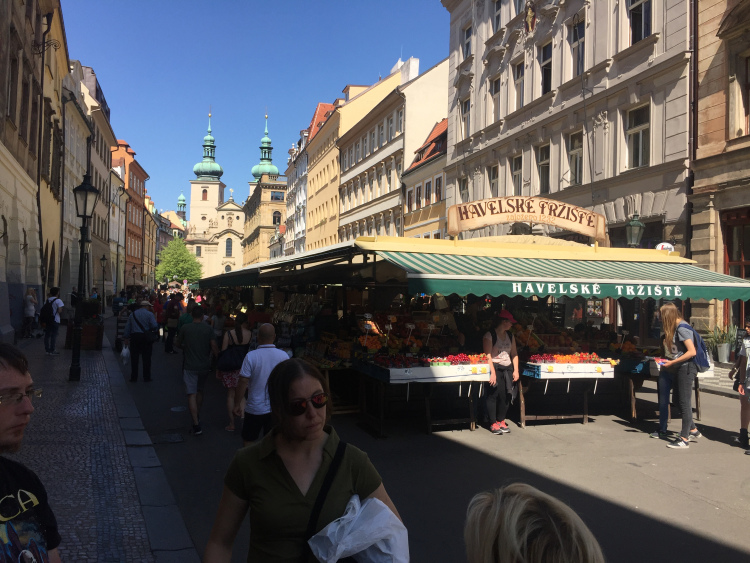By Jim Tanoos, with pictures and activities from annual study abroad visits to Munich, Prague, Hamburg, and Rotterdam by students from Purdue University in Indiana, USA
Before you begin this article, consider reading part one of Jims journey through Central Europe. He begins in Munich, Germany. Click here to read part one.
STOP 2 OF 4: PRAGUE, CZECH REPUBLIC

- Train from Munich to Prague (402km): €26
- One-day public transportation pass x 2 days = €15
- Astronomical Clock tower visit: €9
A SHORT HISTORY OF PRAGUE
The Czech Republic was the longtime industrial center of the former Austro-Hungarian Empire. Some Czechs over 40 years-old many not speak English because the Russians closed off their society from the West behind the Iron Curtain. Even today, they prefer to be referred to as “Central Europeans” rather than “Eastern Europeans”. However, those under 40 generally speak English and enjoy chatting with Americans and discussing American culture. Truly, Czech culture is shaped by their turbulent political history. Since Prague was the only major Central European city to avoid being bombed in World War II, their historic architecture remains in tact, with majestic Baroque, Gothic, and Renaissance-era buildings throughout the city.


Today, the Czechs are proud of building their own modern transportation network, including the continual release of new models of trams. Many of us noticed that some models were newer and had more innovative screens than others. Czech-based Škoda designs and manufactures the Prague public trams (as seen below with the logo on the tram).
Prague was the last democracy to govern in Eastern Europe, but became communist in 1948 and found itself under the authoritarian rule of the USSR for more than 40 years. In 1968, reformists galvanized efforts to allow freedom of the press and other reforms until the USSR deployed 200,000 troops to storm the country and crush the rebellion. The Velvet Revolution was a non-violent shift to capitalism and democracy, that started as a student protest in November 1989 on International Students’ Day, leading to a non-violent era of political upheaval which ultimately led to the first elections since 1946 in June 1990, and the overturning of the one-party communist system. St. Wenceslas Square, the historic center of Prague and a World Heritage Site, has been the epicenter of all the major political protests, speeches, and demonstrations over the years, from the Proclamation of Independence in 1918 to events in the German occupation, to communism, and now capitalism. It was first established in 1348 as a horse market. Take the Metro on either the green A-line or the red C-line and get off at the Muzeum station.

WALK OVER THE CHARLES BRIDGE
St. Wenceslas Square also includes the famous Charles Bridge, first constructed in 1357 during the reign of King Charles IV, who also founded the first University in the city. Take the Metro on the green A-line and get off at the Staroměstská station.

SEE THE FAMOUS ASTRONOMICAL CLOCK
The Gothic chapel in the Old Town Hall includes the famous astronomical clock at the base. The astronomical clock was first installed in 1410 and is the oldest one still operating. Come see the hourly ringing and the mechanical apostles rotating around the two windows above the main dial. A view looking down at the city can be found atop the gothic chapel (see picture below). Take the Metro on the green A-line and get off at the Staromestska station.

INDULGE YOUR TASTEBUDS AT THE HAVEL MARKET
The Havel Market, in Old Town (seen below), has been a public market since 1232, when it was first established as a medieval settlement for trading food. The pace of life moves more slowly and passers-by stroll through Old Town, which still operates as a food market. It’s open from M-F (6am-6:30pm), Saturday (7am-6:30pm), and Sunday (8am-6pm) with numerous vendors selling very inexpensive gifts and food. Take either the green A-line or the yellow B-line and get off at the Mustek station.

EXPLORE THE ICONIC PRAGUE CASTLE
The 9th-century Prague Castle, the largest ancient castle in the world, is the former seat of the kings of Bohemia (see picture below). A Romanesque palace was constructed in the 14th century and visitors can walk freely through the cathedral and around the castle grounds. Don’t miss the changing of the guard every hour from 5am to 11pm. Take the Metro on the green A-line and get off at the Malostranská station.

SEE THE COLORFUL JOHN LENNON WALL
The “Lennonova Zed”, or the John Lennon Wall, is a formerly blank wall that locals began filling with Lennon-inspired artistry and Beatles lyrics in the 1980s. It became a major irritant of the communist regime in Prague during the late 1980s due to the spirit of revolution Lennon espoused during his life. This led to a violent confrontation in 1988 between police and local youth, whom authorities attempted to describe as mentally deranged and agents of capitalist antagonists. Many cite the demand for banned Western music in the late 1980s as the push to end communism. Take the Metro on the green A-line and get off at the Malostranské Náměstí station, followed by a 5-minute walk.

Continue the journey through Central Europe with Jim! Next stop is Hamburg, Germany. Click here to continue. See you in Hamburg!
















This site is protected by reCAPTCHA and the Google Privacy Policy and Terms of Service apply.